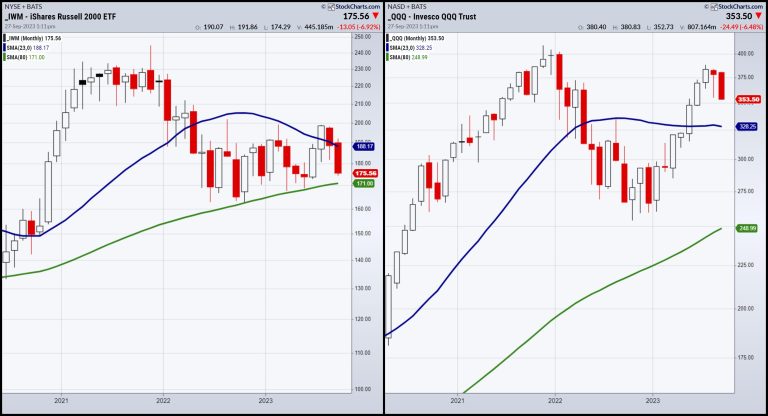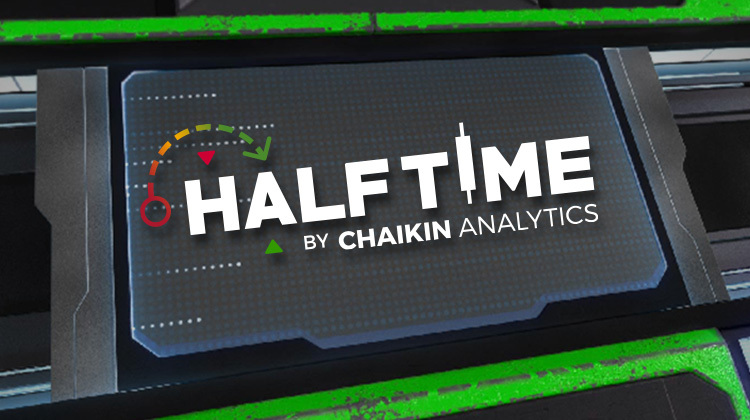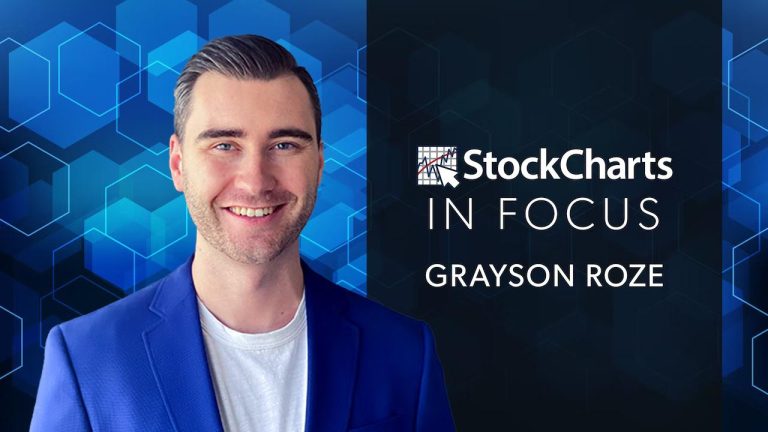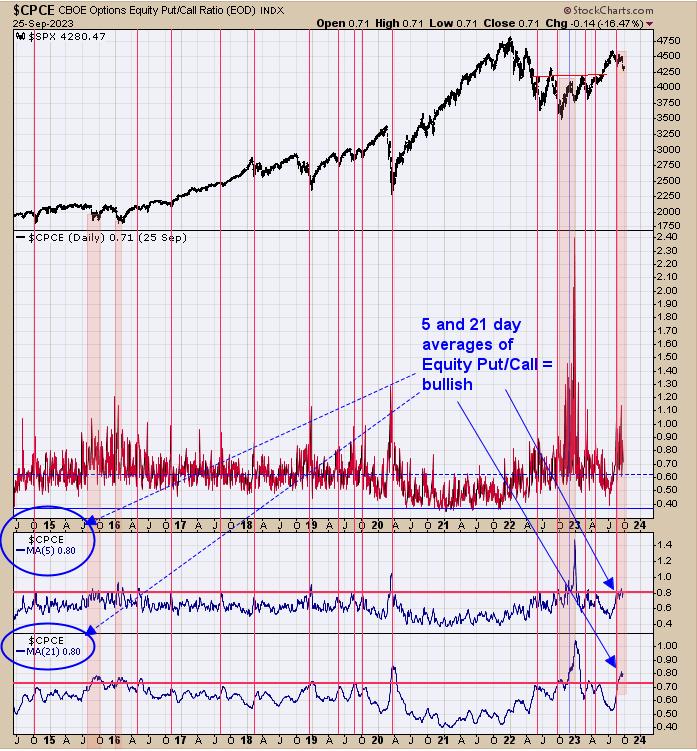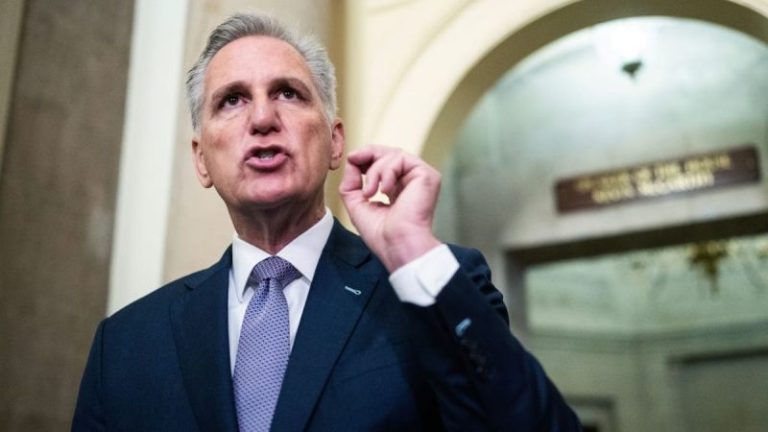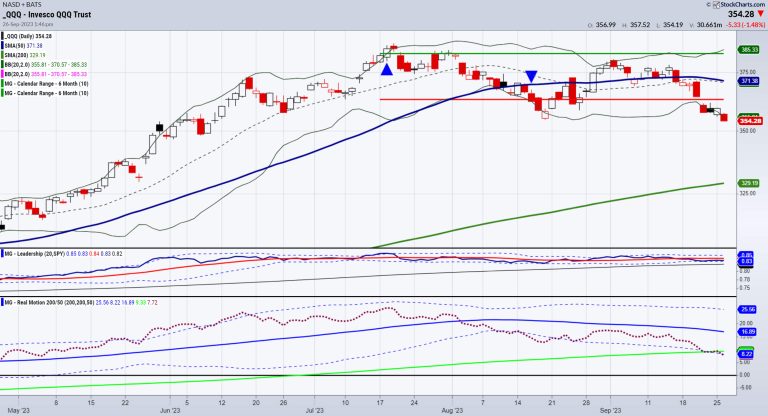We started this year looking at the monthly charts and the 2 moving averages that depict business cycles.
Back in February, we wrote:
All in all, the key sectors (retail, transportation) have more to prove, especially by clearing the 23-month moving average or 2-year business cycle. This is a significant level, as these sectors proved recession was held off when they both held the 80-month moving average or their 6-7 year business cycle low. So, after 2021 was a huge up year and 2022 was a huge down year, 2023, if it clears a 2 year cycle, that looks way better for the economy and market.
Subsequently, Retail (XRT) never cleared the 23-month MA, while Transportation (IYT) did. That prevented us from feeling too confident in a sustaining rally with retail weak.
However, as you can see, the picture has changed.
Retail (XRT) threatens the 80-month moving average once again. Transportation (IYT) has failed the 23-month in September. That gives us two reliable indicators for moving ahead.
Can Retail hold the 80-month MA? If not, here comes recession.
Or can IYT return over the 23-month, engendering more confidence?
Perhaps the small caps and NASDAQ index can shed more light. Small-caps (IWM) fell below the 23-month MA after spending only one month above it. The failure in August to hold above the blue line or 2-year business cycles is a pretty clear sign the higher rates are having an impact on the Granddaddy of the US economy.
Conversely, NASDAQ QQQ broke above the 2-year business cycle high in May 2023. Price ran from $328 to $388 in 3 months as AI and growth have been the winners for a long time. This move lower can see a retracement in QQQ back to 328. After that, so much depends on what happens with IWM, XRT, and IYT.
Nonetheless, one thing is safe to presume. If XRT keeps recession at bay and IYT can rebound back into some expansion, growth will continue to outperform. And if XRT indicates a recession is coming, and IYT plus IWM fail their 80-month MAs, QQQ may still outperform. But we would wait for a move down to 275 as the better buy opportunity in that index.
This is for educational purposes only. Trading comes with risk.
For more detailed trading information about our blended models, tools and trader education courses, contact Rob Quinn, our Chief Strategy Consultant, to learn more.
If you find it difficult to execute the MarketGauge strategies or would like to explore how we can do it for you, please email Ben Scheibe at Benny@MGAMLLC.com.
“I grew my money tree and so can you!” – Mish Schneider
Get your copy of Plant Your Money Tree: A Guide to Growing Your Wealth and a special bonus here.
Follow Mish on Twitter @marketminute for stock picks and more. Follow Mish on Instagram (mishschneider) for daily morning videos. To see updated media clips, click here.
Mish in the Media
See Mish argus investors could jump into mega-tech over value and explain why she is keeping an eye on WTI prices on BNN Bloomberg’s Opening Bell.
Even as markets crumble, there are yet market opportunities to be found, as Mish discusses on Business First AM here.
Mish explains how she’s preparing for the next move in Equities and Commodities in this video with Benzinga’s team.
Mish talks about the head-and-shoulders top pattern for the S&P 500 in The Final Bar.
Mish covers sectors from the Economic Family, oil, and risk in this Yahoo! Finance video.
Mish shares why the most important ETFs to watch are Retailers (XRT) and Small Caps (IWM) in this appearance on the Thursday, September 20 edition of StockCharts TV’s The Final Bar with David Keller, and also explains MarketGauge’s latest plugin on the StockCharts ACP platform. Mish’s interview begins at 19:53.
Mish covers 7 stocks that are ripe for the picking on the Wednesday, September 20 edition of StockCharts TV’s Your Daily Five, and she gives you actionable levels to watch.
Take a look at this analysis of StockCharts.com’s Charting Forward from Jayanthi Gopalkrishnan, which breaks down Mish’s conversation with three other charting experts about the state of the market in Q3 and beyond.
Mish was interviewed by Kitco News for the article “Oil Prices Hit Nearly One-Year High as it Marches Towards $100”, available to read here.
Mish covers short term trading in DAX, OIL, NASDAQ, GOLD, and GAS in this second part of her appearance on CMC Markets.
Mish talks Coinbase in this video from Business First AM!
Mish looks at some sectors from the economic family, oil, and risk in this appearance on Yahoo Finance!
Mish covers oil, gold, gas and the dollar in this CMC Markets video.
In this appearance on Business First AM, Mish explains why she’s recommending TEVA, an Israeli pharmaceutical company outperforming the market-action plan.
As the stock market tries to shake off a slow summer, Mish joins Investing with IBD to explain how she avoids analysis paralysis using the six market phases and the economic modern family. This edition of the podcast takes a look at the warnings, the pockets of strength, and how to see the bigger picture.
Mish was the special guest in this edition of Traders Edge, hosted by Jim Iuorio and Bobby Iaccino!
In this Q3 edition of StockCharts TV’s Charting Forward 2023, Mish joins a panel run by David Keller and featuring Julius de Kempenaer (RRG Research & StockCharts.com) and Tom Bowley (EarningsBeats). In this unstructured conversation, the group shares notes and charts to highlight what they see as important considerations in today’s market environment.
Coming Up:
September 29: Live Coaching
October 2: Schwab, The Watch List
October 4: Jim Puplava, Financial Sense
October 5: Yahoo! Finance
October 12: Dale Pinkert, F.A.C.E.
October 26: Schwab at the NYSE
October 27: Live in-studio with Charles Payne, Fox Business
October 29-31: The Money Show
Weekly: Business First AM, CMC Markets
ETF Summary
S&P 500 (SPY): There are multiple timeframe support levels round 420-415.Russell 2000 (IWM): 170 huge.Dow (DIA): 334 pivotal.Nasdaq (QQQ): 330 possible if can’t get back above 365.Regional Banks (KRE): 39.80 the July calendar range low.Semiconductors (SMH): 133 the 200-DMA with 147 pivotal resistance .Transportation (IYT): 225 next support.Biotechnology (IBB): 125; if clears, impressive.Retail (XRT): 57 key support.
Mish Schneider
MarketGauge.com
Director of Trading Research and Education

